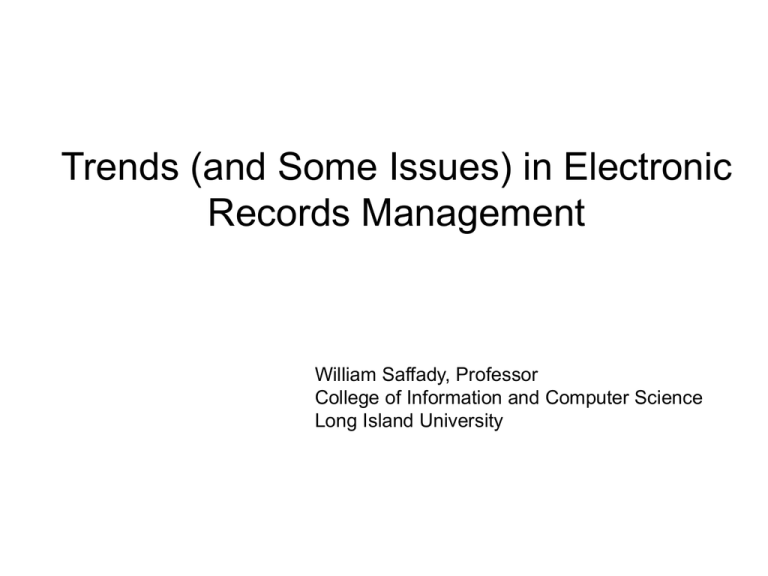Trends in Electronic Records Management
advertisement

Trends (and Some Issues) in Electronic Records Management William Saffady, Professor College of Information and Computer Science Long Island University Important characteristics of electronic records Contains machine-readable rather than human-readable information Information originates as electronic signal Any type of information Quantitative data Character-coded text Images Sound Electronically encoded: digital or analog Important characteristics of electronic records Originating devices Computers of all types Scientific and medical instrumentation Video recorders Audio recorders Obsolete devices Physical forms Magnetic media Optical media Other Issues and Concerns Growth of electronic records Quantity: paper vs. electronic records The cause: proliferation of information processing technology: computers, storage, software E-business and E-government initiatives Importance of electronic records Many support mission-critical applications Computers automate most important activities, store most valuable information Computer records more complete than source documents Issues and Concerns Inadequate controls for creation, storage, retention Computers are commonplace but operational guidelines are rare Many records management decisions guided by user discretion Information redundancy Same information in electronic and non-electronic formats -- the problem of “official copies” Problems of space, control, coordination of retention actions Issues and Concerns System dependence Hardware Software Media stability Data migration requirements Periodic recopying of media Periodic conversion of records to new file formats Remote access: an advantage and a security problem Issues and Concerns E-discovery issues The duty to preserve evidence in all formats Amended Federal Rules of Civil Procedure Broadens discovery process to include records of all types Electronic records must be produced in usable format Attorneys must understand electronic recordkeeping infrastructure Accessibility of backup copies, archived copies, legacy data Some Ideas and Trends The declining cost of storage Do retention guidelines play an important role in cost reduction? Are retention actions cost-justifiable? Concept of Total Cost of Ownership for electronic storage -- is purging more expensive than keeping? Cost consequences of indefinite retention beyond storage costs The problem of email and fileshares Problem of discretionary retention Does a uniform maximum retention period make sense? Some Ideas and Trends Electronic records as official copies Definition Advantages: compactness, reusability, backup Complications for long retention Data migration requirements Keeping legacy systems in service “Born digital” vs. conversion of paper records to digital formats for retention Some Ideas and Trends Software solutions Email “vaults” Records management application software Concept -- relationship to document management software Role of DoD 5015.2-STD Preconditions for successful implementation Retention schedules cover electronic records File taxonomy to organize records Document management software for active records Automatic categorization




